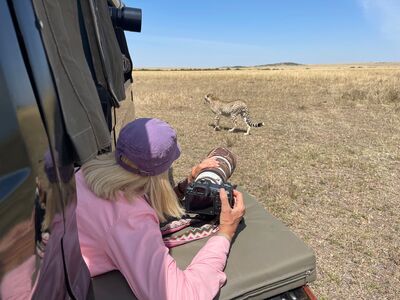Pretty in pink and an elephant!
Nov 1, 2022 10:10:07 #
Nov 1, 2022 10:46:22 #
Nov 1, 2022 11:20:31 #
Photolady2014 wrote:
There are two species of Flamingos in Kenya althou... (show quote)
Superb shots - and I thank you for showing me my first shot of a flamingo flying - ever 🎯🎯🎯🎯🎯
Nov 1, 2022 11:23:12 #
Nov 1, 2022 11:40:22 #
Photolady2014 wrote:
There are two species of Flamingos in Kenya althou... (show quote)
Lovely set - and thanks for the background information.
Nov 1, 2022 12:06:40 #
joecichjr wrote:
Superb shots - and I thank you for showing me my first shot of a flamingo flying - ever 🎯🎯🎯🎯🎯
Wow, glad you liked it!
Nov 1, 2022 12:06:55 #
DebAnn wrote:
Lovely set - and thanks for the background information.
More than welcome!
Nov 1, 2022 12:08:53 #
jerryc41 wrote:
Nice! We certainly have a strange assortment of life on earth.
And colorful!
Nov 1, 2022 12:09:27 #
sandylynn wrote:
Your images are fantastic. How cool to of been there and photograph them and by the way I enjoyed the info on them. Congrats and great shots.
Thanks so much!
Nov 1, 2022 12:10:02 #
JimmyTB wrote:
Excellent set! Don't apologize for all the info you gave. I ate it up and anyone not interested can just scroll down to the beautiful pix. 





I’m glad you liked it!
Nov 1, 2022 12:32:15 #
Nov 1, 2022 15:19:50 #
tcthome
Loc: NJ
Great set. Like you threw in the elephants photo to boot. Also, thanks for the great info write-up.
Nov 1, 2022 15:45:00 #
Nov 1, 2022 16:48:22 #
Photolady2014 wrote:
There are two species of Flamingos in Kenya althou... (show quote)
Beautiful pictures of both the flamingos and elephants.
Nov 1, 2022 19:31:15 #
Photolady2014 wrote:
There are two species of Flamingos in Kenya althou... (show quote)
Why do they always look so angry. Because they can’t smile.
If you want to reply, then register here. Registration is free and your account is created instantly, so you can post right away.







